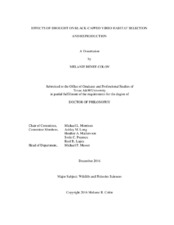| dc.description.abstract | Texas experienced extreme drought conditions in 2011, followed by moderate conditions the next year. I examined the effects of these annual weather conditions on habitat selection and reproduction of a federally endangered songbird, the Black-capped Vireo (Vireo atricapilla; hereafter vireo), in Texas. Vegetation and topographic characteristics in vireo territories and at vireo nest-sites were similar across years. However, vireos used different nesting substrates depending on year. Vireos typically nest in deciduous substrates, but they used Ashe juniper (Juniperus asheii), an evergreen species, as a nest substrate more frequently in 2011. This was, perhaps, because it was one of few plant species with consistently leafy foliage. Vireos had lower pairing and fledging success in 2011 than in 2012. Clutch size and brood size did not differ by year, but vireos delayed nest initiation and, consequently, laid fewer eggs and had fewer nesting attempts in 2011. Delayed nest initiation is often associated with reduced food availability, and it may provide a mechanism whereby individuals can reduce reproductive effort and increase survival when resources are limited. However, it is not without consequence as later nests may be subject to greater predation or brood parasitism by Brown-headed Cowbirds (Molothrus ater). During this study, predation and brood parasitism were higher in 2011, and year, substrate, and nest concealment best predicted nest success. Daily nest survival decreased over time in both years, but was lower in 2011. Annual variation in songbird reproduction is common and can be attributable to factors unrelated to weather. However, the responses of, and consequences to vireos during the 2011 season are similar to those observed for birds nesting in other regions with variable rainfall that are periodically exposed to drought events. Drought is not preventable, but by understanding how at-risk species respond to it, we can better manage their populations. Common management strategies for vireos include removal of Ashe juniper and Brown-headed Cowbirds from vireo habitat. In drought-prone regions, managers should consider retaining some Ashe juniper in vireo habitat to provide refuge for foraging and nesting during dry conditions. Additionally, increased Brown-headed Cowbird removal efforts during drought years could reduce parasitism risk. | en |


